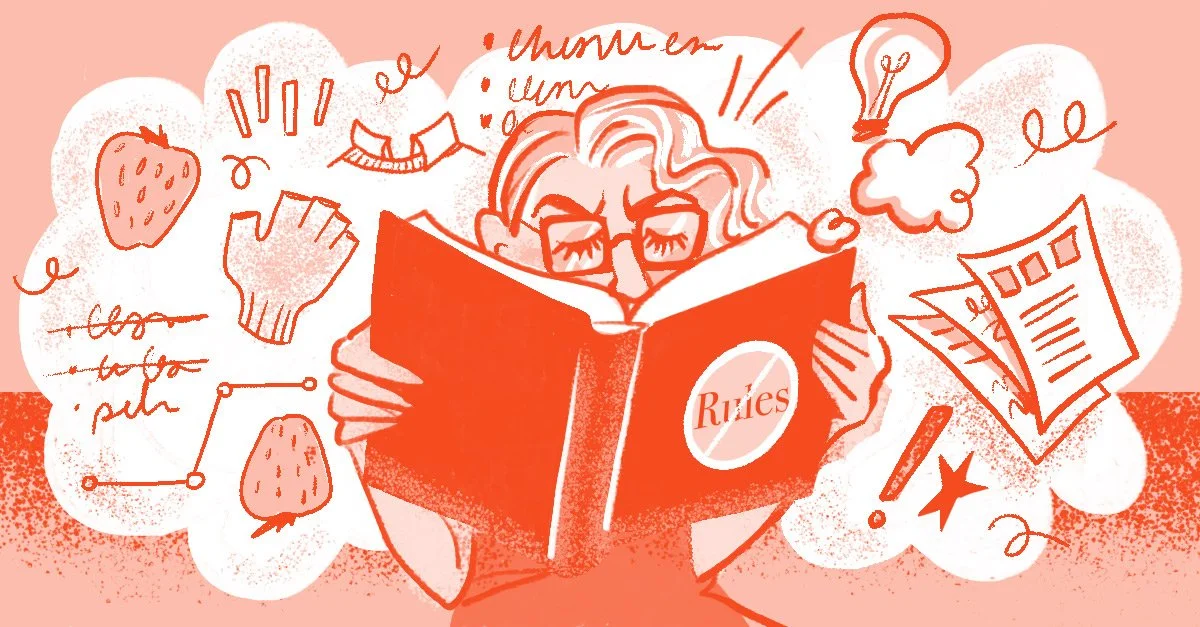A Perfectionist’s Guide to Creativity
The lip of his shirt collar is caught on the top of his jumper. It’s taking all my willpower not to flip it. One strawberry slice on the cake is facing the wrong direction and has the tiniest piece of green attached. Sigh. The waste basket taunts me; there are pencil shavings stuck in its weave. I know it will never be truly empty. The missing fingerless glove is grabbing real estate in my brain. Real estate I need to conquer my second mountain. Because one is no longer enough. Welcome to my internal chatter. Overthink, over revise, over analyze. I am a self-confessed perfectionist.
Well, this perfectionist is riding the Central Line in London, reading a career memoir from an advertising legend: There Are No Rules. Another book highlighting the essential ingredients for creativity, the typical list of pre-required personality traits: be playful, fearless, and a rule breaker. At Stratford Station, I have an epiphany: My whole life I’ve been writing the opposite book—“There Are Some Rules.” And here’s why: A world without rules is a tricky place for a perfectionist.
How Can I Get an A+?
The way creativity is currently sold is a hard pill to swallow for a perfectionist. How can you get an A+ when it’s all subjective? How can you enjoy the comfort of rules when they’re all supposed to be broken? How can you be messy when all you want to do is tidy up? And the real kicker: How can you be fearless when mistakes are the enemy? In the same way we understand that a dyslexic kid requires new tools for reading, the perfectionist mindset requires a different approach for unlocking creativity. And no, that approach is not simply “to be less perfect.” We would never tell an anxious person to just be less anxious, would we?
Let’s take having ideas as an example of creativity. We’ve all been asked to have an idea at some point, whether at home, at school, or at work. Yet most people struggle to define what an idea actually is and even more people have never been taught how to have one. It’s hardly the invitation the perfectionist dreams of: achieve something for which there is no definition or method for achieving it. There’s an easy solve for this that doesn’t cramp the magic of creativity: Share the helpful underlying structures behind creative endeavors. Give the perfectionist a handrail.
In many creative projects there are places to hold tight and places to let go. The hold tight moments often involve the underlying structure. For a storyteller, this may be the five parts of a great story; for the screenwriter this may be the three-act structure; for the painter this may be a color value study; for the creative problem solver it may be problem/insight/idea. These simple structures extend a beautiful invitation for the perfectionist to get involved. There is something to learn, there’s direction and comfort, and, most importantly, this structure frees up energy
for the riskier parts of the endeavor.
Perfectionism Is Rife Among Women and Girls
This perfectionist outreach is all the more pertinent when you consider that perfectionism is rife among women and girls. In her brilliant book Brave, Not Perfect, Reshma Saujani quotes a study that asked a room of high school girls “How many of you strive to be perfect?” Ninety-nine percent of hands shot up. By college, this perfectionism causes girls to reject subjects in which they don’t initially get a good grade. (The Harvard Economics professor Claudia Golden revealed that women who earned B’s in Introductory Economics are far more likely to switch majors that those who earn A’s—while their male counterparts stick with it, even if it’s a B.) By adulthood, this perfectionism hurts career choices with the now-famous corporate report showing men apply for a job when they meet only 60% of the qualifications, but women only apply if they meet 100%. How many girls and women are rejecting creativity right now, either as a life-affirming hobby or a life-affirming career choice? And how many great ideas are we leaving on the table as a result? Because if there are no rules you’re definitely not going to get a good grade and you can’t even meet 60% of the qualifications, let alone 100%.
Do not confuse providing form with providing a formula. Giving perfectionists too many rules is as paralyzing as too few. We perfectionists will want to follow them all. However, a little less romanticization of creativity and a little more skill sharing can open the door to a whole new creative cohort. To transition from Type A to Type C, we don’t need “no rules” or “all the rules.” Just “some rules.” Provide us perfectionists with the handrail, the safety harness, the fifth wheel on the roller skate, and watch us spin magic.
Sources: Brave, Not Perfect

